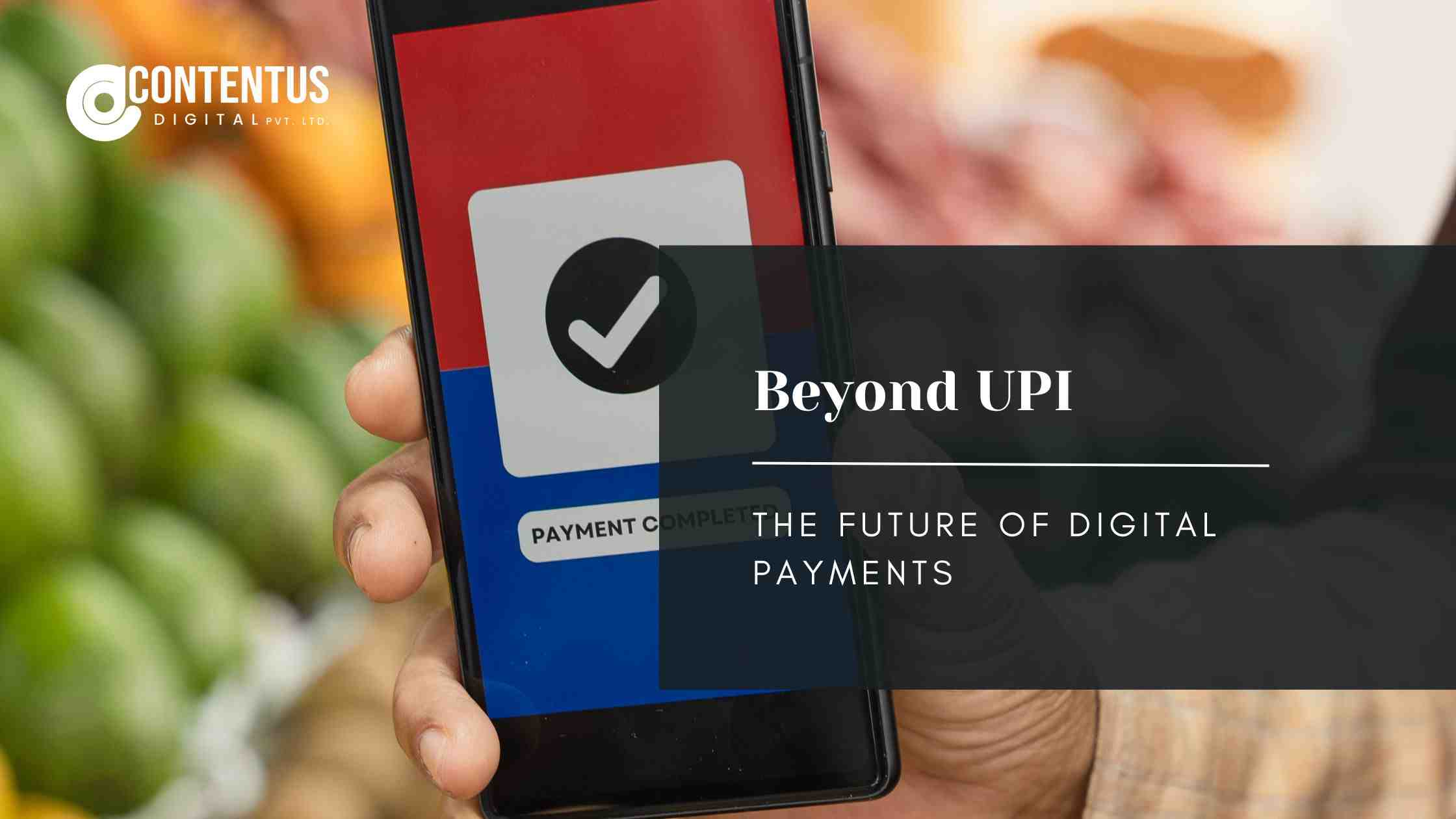Beyond UPI: The Future of Digital Payments
Table of Content
1 | Introduction |
2 | The Current landscape of UPI |
3 | The trends beyond UPI in payment industry that will rule in future |
4 | Innovations in payment modes and credit availability in India |
5 | Integrating big data analytics for payment solutions |
6 | The impact of regulatory development in the future of digital payment |
7 | Conclusion |
Over the past decade, the global digital payment landscape has undergone a radical transformation with technological advancements in the industry. The Unified Payments Interface (UPI) technology of India is at the forefront of this transition. With over 10 billion monthly transactions recorded, UPI has set a global benchmark in digital payments. But not just UPI, the future of digital payments will also be driven by other payment technologies.
So, this article will draft the estimated future trends in digital payments and their benefits that would often crafted by specialized promotional content writing services.
The Current landscape of UPI
UPI has experienced exponential growth in the last few years. Now it has become the backbone of India. According to the RBI (Reserve Bank of India), the transaction volume through UPI reached 185.8 billion in FY25, which is 41.7% higher than 131.1 billion transactions in FY24. It incorporates multiple features: QR code-based payments, virtual payment addresses, and push and pull payments. These features help UPI to reshape the digital payment industry and become one of the major global payment trends.
Due to its speed, convenience, security, and adaptability, Indian UPI is endorsed and glorified beyond the country. For instance, France, Singapore, the UAE, Nepal, Bhutan, Sri Lanka, and Mauritius have already accepted this technology. Moreover, countries like Malaysia, the UK, the Maldives, and more will be initiating this digital payment technology in the near future.
The trends beyond UPI in the payment industry that will rule in the future
But the topic of this article is not UPI. You already know a lot about UPI, and maybe you’re using this technology for finance management. So, we’ll talk about the other leading trends that will dominate the future of digital payments globally.
Digital wallets
Being the electronic version of physical wallets, these store payment information to make quick and secure transactions. As there is a consistent surge in smartphone users, the usage of digital wallets has also increased in recent years. According to Juniper Research the global transaction value in 2024 was USD 10 trillion in total and the estimated value for 2029 is USD 17 trillion.
The consumers benefit from this initiative in terms of speed, security, and reliability. The merchants reap several rewards whenever they increase transaction volumes, access valuable user data, and reduce operational costs. Moreover, there are several government initiatives to fuel the growth of digital wallets in the upcoming years. This way, the discussion serves as a promotional writing to underscore the advantages of digital wallets in the future digital payments landscape.
Contactless payments
As the name suggests, contactless payments enable fast and secure transactions without any physical contact. Primarily, these payments have been executed by Near Field Communication (NFC) technology that enables payments through tapping cards or smartphones on the terminals. Then, QR codes arrived on the scene. It requires just a proper scanning of the code to initiate the payment.
This practice has been accelerated from the time of the COVID-19 pandemic when consumers prioritised social distancing and hygiene. Now, with the growing demand and technological advancements, contactless payments have become a significant trend for the future of digital payments.
Buy Now, Pay Later (BNPL)
BNPL is a trend for the future of digital payment that allows users to make purchases first and then pay in installments. The installments should be payable within a short period and interest-free. It provides advantages for both the consumers and merchants. For example, consumers manage their budget better, improve affordability, and have access to credit that helps those who have limited credit history.
On the other side, merchants can increase their sales, customer loyalty, and average order value through BNPL options.
Blockchain and cryptocurrencies
Incorporating decentralized architecture and immutable ledger, blockchain technology enables secure and transparent financial transactions. The major advantage of this technology is that it doesn’t require the presence of intermediaries to complete financial transactions. Thus, it promotes peer-to-peer payments. Additionally, the transaction details are immutable. That means nobody can change your transaction details anymore. By utilizing encryption, blockchain payments ensures immutability of transaction data.
Also, cryptocurrencies such as Bitcoin and Ethereum also gained traction and expanded their applications. However, there are potential risks associated with cryptocurrencies, too. Thus, governments are focusing on developing a more robust regulatory environment.
Central Bank Digital Currencies (CBDCs)
Central banks worldwide are developing the digital version of their national currencies. These are known as CBDCs, which is another impactful trend in the future of digital payments. These currencies aim to facilitate digital payments with security and sustainability backed by the central banks.
During the crisis of COVID-19, CBDCs established their first footprint in the financial industry. Currently, 87 countries are exploring CBDCs, and 9 of them have already launched a state-owned digital currency. These digital currencies also depend on the decentralized approach that is adopted by the central banks. However, privacy and efficiency are the major concerns for the CBDCs. Thus, the central banks are focusing on more secure, efficient, and faster CBDC projects.
E-commerce payments
The growth of online shopping takes the digital payment evolution to the next level. As online shopping grows, the demand for secure and instant payments also rises. Thus, the e-commerce industry also propelled its payment systems. The industry allows credit/debit cards, digital wallets, and net banking as part of secured payment options. And now these options have become more popular among the customers.
According to WorldPay 2025, the direct use of credit and debit cards will be around 20% and 12% in e-commerce payments in 2024.
Fintech collaborations
Another major trend is collaboration between traditional banks and fintech companies. Nowadays, these collaborations are driving customer experience and enhancing innovations. As a result, there are more possibilities for developing new products and services that will provide a seamless experience for the users. For example, entities collaborate to build embedded financial solutions, co-branded credit cards, and digital lending platforms. Moreover, the succesful market penetration of those innovations depend upon resonating narratives developed by experts promotional content writing services.
Innovations in payment modes and credit availability in India
Since the last decade, India has seen a sustainable growth in digital payments fostering innovations in the payment industry. Thus, the digital payment landscape is incorporating new use cases to extend more payment options.
So, let’s see what those options are –
Credit penetration and availability
A recent escalation in credit penetration in India indicates a robust growth in credit facilities. This surge targets several industries such as loans, retail, agriculture, and SME. In the last year, banks and NBFCs experienced an acceleration in high-credit average ticket size (ATS). Significantly, low credit ATS has witnessed slower growth. Moreover, the entire loan value has grown by up to 21% within the country.
Payment aggregator for cross-border (PA-CB)
RBI has issued PA-CB guidelines on 31st October 2023 that allows non-banking entities to enter in the payment aggregation business. It also expands the scope of the services they import. As a result, the PA-CB businesses can operate independently without any support of the AD (Authorized Dealer) banks. However, entities planning or cross-border payments must ensure their services comply with the latest PA guidelines of the RBI.
Interoperability of net banking
The RBI has initiated interoperability in net banking transactions to mitigate delays in merchandise payments and settlement risks. By streamlining the payment processes, it makes the payments faster that also results in quick settlements for the merchants and improves user experience. It not only solves the settlement issues but also foster innovation, cut down usage and platform charges.
Financial ecosystems with insurance, payments, lending, and wealth
Many banks, FinTech corporations, and NBFCs are developing a comprehensive financial ecosystem with payments, insurance, lending services, and wealth management. Sounds quite unfamiliar? But it’s true. These institutions are offering these services through superApps. These superApps offer versatile financial and non-financial products and services. These all-in-one service-providing platforms simplify financial management, making them increasingly popular.
Integrating big data analytics for payment solutions
Apart from the trends mentioned above, big data and analytics have become one of the major upcoming global payment trends. These tools and technologies acquire deep insights from customer data that help to provide more personalized services. Also, big data and analytics identify potential market opportunities, demand trends, spending patterns, and resource allocation optimization. This way, big data drives innovations in the field of digital payments.
Here are some major use cases about how big data analytics are integrated for digital payment solutions –
Real-time transaction settlement and monitoring
Big data automates repetitive payment tasks using natural language processing (NLP) and optical character recognition (OCR). These help in machine vision for cheque deposits and touchless invoice processing. Moreover, it reduces settlement time by predicting requirements and changes in real time.
Personalized payments and financial solutions
Big data analytics helps in credit risks assessments by analyzing huge data sources for real time credit limit adjustments and underwriting decisions. Furthermore, it enables financial institutions to utilize non-traditional data, allowing them to accept more applications for financial services. Even if the applicants have a lack of credit history, they still keep themselves outside the risks of defaults due to the blessings of non-traditional data.
Fraud detection and prevention
Fraud prevention is another concern in the world of digital payments. But it becomes easier with the help of big data analytics. Analyzing massive transaction data and unlocking the complex patterns, big data can safeguard the payment industry from potential fraud. It uses machine learning algorithms to flag suspicious transactions that raise the risks of fraud.
Customer support service
Moreover, big data analytics also assists the chatbots and virtual assistants in answering payment queries without any human intervention. With the help of big data, chatbots can quickly access and process massive amounts of customer data. These help them to provide accurate and personalized answers for the users.
The impact of regulatory development on the future of digital payment
The regulatory environment related to digital payments has become more complex, day by day. Thus, it requires consistent development and upgradation, including security enhancement, protecting consumer interests, and promoting competition. Thus, staying informed about those changes helps the stakeholders to understand the current scenarios of the regulatory environments.
Here are some key regulatory developments in India and the USA.
The RBI has established year-wise digital payment targets and boosted up the payment acceptance infrastructure by outlining several initiatives.
The USA has implemented data privacy and fraud prevention regulations that support the FTC & CFPB (Federal Trade Commission and Consumer Financial Protection Bureau) crackdown on AI-driven fraud and dark patterns detections. Specifically, these regulations become suitable for tokenization, biometric authentication, and behavioral analytics.
FinCEN’s updated Anti-Money Laundering (AML) rules offer comprehensive AML and KYC guidelines for cross-border payments. These rules also encourage investments in AI-powered compliance solutions for automated fraud detection.
Conclusion
Undoubtedly, the future of digital payments in India will be ruled by UPI. Now, the UPI has reached a global adoption stage. Many foreign countries have already integrated this technology, and many have shown their interest in it.
Plus, there are several innovations and financial inclusions that foster trust and security in the payment environment. From digital wallets to CBDCs, there are several trends that will contribute to the promising future of digital payments. And this article aims to showcase their potential and benefits through its promotional writing.







